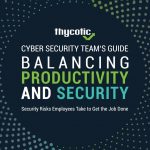Industry Talk
Regular Industry Development Updates, Opinions and Talking Points relating to Manufacturing, the Supply Chain and Logistics.How AI Can Help Defense Contractors Weather Today’s Uncertain Times

For defense contractors, efficiency is paramount whether you’re operating in a high-growth climate or in an uncertain market that demands greater austerity. Whatever the case, the firm bottom line is going to benefit from running your business and your projects in a leaner, more intelligent way.
In a business landscape as uncertain as today’s, capturing new efficiencies across the organization and within individual projects should be a major point of emphasis. But which areas of your business are ripe to capture efficiencies? And what tools are available to help you capture them?
Having spent decades supporting defense contractors in their efficiency efforts during government shut-downs, recessions and other trying times (and during brighter times, too), I see several areas that look particularly fruitful for capturing new efficiencies — with the right intelligent capabilities and automation tools at hand:
Project management and execution. Versatile tools that that they are, artificial intelligence and machine learning can positively impact projects on multiple fronts. For example, AI capabilities within an enterprise resource planning (ERP) system can alert decision-makers to cost trends and potential overruns, and even offer suggestions for how to address them. Throughout the lifecycle of a project, AI tools also can glean insight from real-time timesheet and payroll data and other sources, then provide project managers with up-to-the-minute information on project status, delays, milestones, cost trends, potential budget variances, and resource utilization, so they have a true picture of where a project stands and can promptly address issues before they escalate. Using natural language processing capabilities, AI also can extract key project information from emails, contracts, and reports to support timelier decision-making. Using AI-driven predictive analytics, meanwhile, companies can optimize the composition of project teams based on an analysis of peoples’ skills, certifications, and performance. Put all this together and the result is more efficient, better project outcomes, which in turn help to strengthen client relationships and produce more repeat business.
Resource management is another area of the PM office where AI is proving its value. Predictive analytics can match in-house and contractor skills to specific projects and show companies how to optimally reallocate resources based on changing circumstances with contracts.
Finance and accounting. In uncertain times, cash-flow certainty is a must. Too often, however, manual, error-prone processes hamper a firm’s ability to realize revenue. Intelligent automation of accounts receivable (AR) processes can remove cash flow bottlenecks by ensuring that project data migrates within and across systems accurately, alerting the appropriate people when data is missing or inaccurate, and even finding and placing missing data where it belongs. Intelligent automations can also create billing statements and send notices to customers, then record payments across systems. Not only does this relieve finance and accounting teams of manual work, it tightens invoice cycle time substantially (by 75% in many cases), helping companies get paid more efficiently, securely, and accurately, which in turn brings more certainty to forecasting and planning. Accounts payable (AP) processes can be similarly automated to ensure subcontractors and vendors are paid on-time.
Project pipeline. By applying intelligent analytics to their pipeline and current project backlog, firms can identify at-risk contracts. This in turn informs the steps firm decision-makers take to mitigate that risk, such as by increasing proposal output. More on that in a moment.
Compliance. A heavy compliance burden comes with the territory as a defense contractor, and AI can do a lot to relieve that burden by helping with audits, the Federal Acquisition Regulation (FAR), DFARs, CAS and CMMC 2.0. For example, AI models can be trained to interpret complex regulatory language so it’s more understandable and actionable, and flag compliance risks like mismatched data or unallowable costs. AI also can save companies vast amounts of time by creating and confirming compliance with policies and procedures, monitoring time and expense entries, and gathering and formatting data required for specific contract reporting requirements. AI models can be trained to interpret and summarize complex compliance language so it’s understandable and actionable. And for cybersecurity compliance, firms can use AI content-creation tools to help draft the system security plans that are integral to clearing the CMMC process.
Business development. From combing the defense contracting arena for the right opportunities, on through to proposal creation, intelligent tools [some of which come embedded in customer relationship management (CRM) systems built specifically for government contractors] can help firms capture new efficiencies across their business development operations. It starts with identifying opportunities. Today’s AI-powered market intelligence capabilities can quickly and thoroughly scan the public domain for relevant RFPs and bid opportunities, then provide a consistent stream of prescreened opportunities. Instead of blind spots causing firms to overlook high-potential opportunities, they are alerted to opportunities their competitors might miss.
Once those opportunities are identified, firms can use analytics to score and prioritize opportunities based on parameters like win probability, estimated project profitability, and alignment with the firm’s strategic priorities, so they can fill the pipeline with the kinds of new work that’s most winnable, profitable and desirable. Decisions about specific kinds of customers and projects to prioritize for pursuit are informed by data, not just gut instinct.
Then, come proposal-creation time, firms can let intelligent tools handle tasks like gathering, standardizing, and organizing data and content culled from various sources for a specific RFP, and turning it into a coherent whole using automated proposal templates, so your proposal team can focus on the elements of a proposal where a human touch can really make a difference. Using AI tools, a defense contractor can create a high-quality first proposal draft (the “pink team” draft) for a federal RFP in a matter of hours. Ultimately, these tools can cut average RFP time-to-draft by 70% and slice potentially six-figure proposal-generation costs in half, while increasing a firm’s overall proposal capacity 15-20% — without an increase in headcount.
For U.S. defense contractors, the coming years promise a wealth of new business opportunities in light of the huge amounts Uncle Sam proposes to allocate for defense spending in 2025 and beyond, including $895 billion in the current fiscal year. By arming themselves with intelligent capabilities like these, companies put themselves in a strong position to win their fair share — and hopefully more — of that new business.
Author Bio: Kim Koster is Vice President of Product Marketing at Unanet, a software company that provides enterprise resource planning and customer relationship management solutions for organizations in the government contracting, architecture, engineering, construction and professional services industries.










